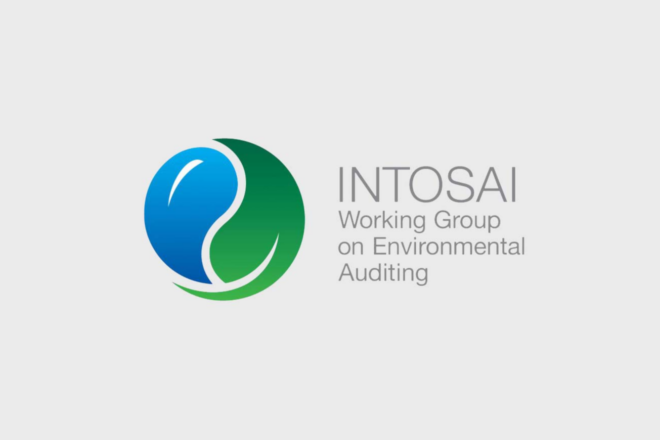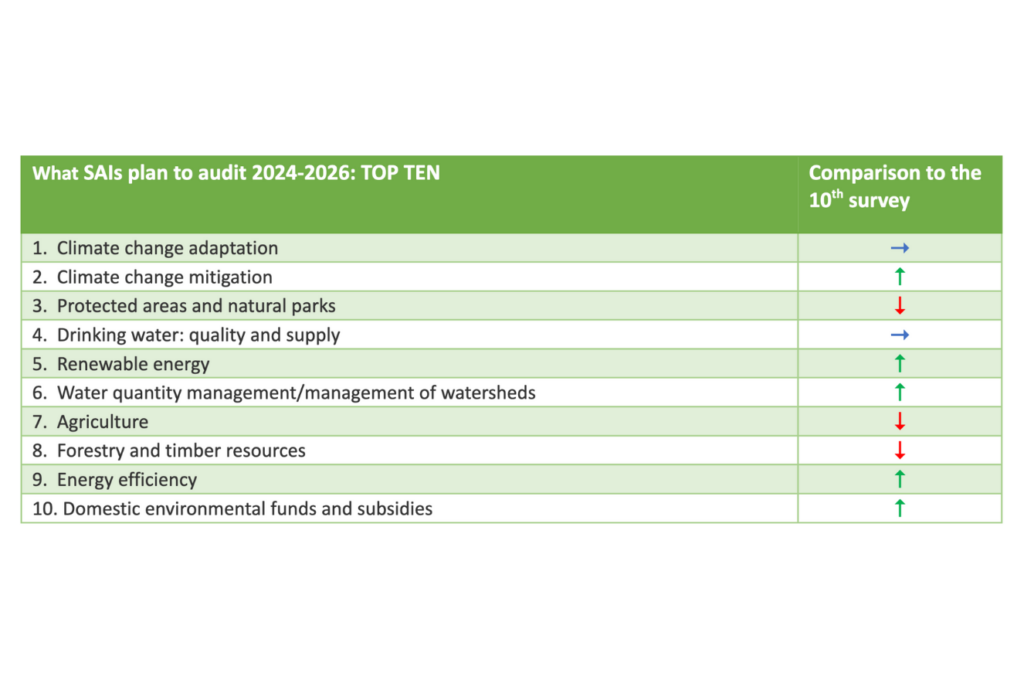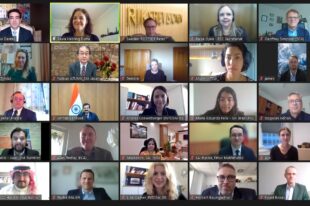Climate Change: A Rising Priority for Supreme Audit Institutions

Author: Vivi Niemenmaa, Secretary General of the INTOSAI Working Group on Environmental Auditing, National Audit Office of Finland
The INTOSAI Working Group on Environmental Auditing (WGEA) has observed an increasing diversity in audits on climate action. In addition to climate change mitigation, Supreme Audit Institutions (SAI) are increasingly auditing climate change adaptation and social aspects. At the same time, developing country SAIs are becoming more engaged. The latest INTOSAI WGEA survey shows that SAIs’ interest in environmental audits and auditing climate action continues to grow.
INTOSAI WGEA has mapped the state of environmental auditing for the 11th time in its triennial surveys. Environmental auditing is not a new topic for most survey respondents: over half of the 82 respondent SAIs have conducted environmental audits for over ten years, most often as performance audits.
The 11th survey shows that the popularity of climate audits continues to rise. Firstly, SAIs consider climate change to be the most pressing environmental issue. Secondly, climate change adaptation was most popular environmental audit topic in 2021-2023, followed by agriculture and waste. Furthermore, in 2024-2026, SAIs will continue to prioritize climate change adaptation, followed by climate change mitigation (reduction of greenhouse gases) and protected areas.

There will be more audits in global South and on adaptation
But let’s first look into the past. In the sphere of the WGEA, the climate change had established itself by 2010. Most of the audits back then were, however, conducted in the global North, and with a predominant focus on climate change mitigation. For example, the global coordinated audit on climate in 2010 included only few audit cases on adaptation.
As the impacts of climate change have become evident, international climate policy has started to stress the need to adapt to the changing climate. With the development national adaptation policies and funding, audits on assessing their implementation have also increased. The ongoing global Cooperative Audit on Climate Change Adaptation Actions, powered by the INTOSAI Development Initiative and involving around 50 SAIs, will increase the number of adaptation audits. Together with another major global project, ClimateScanner initiated by SAI Brazil, the number of reviews and audits will also increase in global South. In the context of ClimateScanner, while reviewing their governments’ activities on climate, SAIs have a marvelous opportunity to identify further audit topics.
Audits have covered whole policy areas and sector-specific action
SAIs have approached climate action in various ways and audits have covered whole policy areas and sector-specific actions. For example, SAI France dedicated its last annual report for adaptation, while SAI UK has audited government’s net zero targets. Additional approaches include SAI Canada’s review of its earlier reports and federal government’s track record on climate change since 1998, whereas SAI USA has developed a disaster risk resilience framework and applied it in several audits. However, it is more typical to audit the implementation of actions in specific sectors, such as transport, agriculture or energy. For example, many small island developing states in PASAI region are currently assessing actions to protect islands from sea level rise, while SAI Finland has audited international climate finance from the donor perspective.
Recently, some SAIs have audited the social aspects related to climate change, such as the implementation of policies supporting a just transition, i.e. attention to those who might suffer from the phasing out of the fossil fuel economy. Consequently, audits on climate change have become more diversified.
The overall conclusions of performance audits in the INTOSAI WGEA database are not much different from performance audits in other policy sectors. SAIs call for better risk management and impact assessments, a more strategic approach, effective implementation of policies and improved cost-consciousness, better coordination between government sectors and levels, as well as better monitoring and reporting. SAIs also stress more transparent information on investment needs, climate spending and taxation, as well as tax reliefs that have a negative impact on climate.
Many of the audit findings on climate action are not much different from performance audits in other policy sectors. However, some specific features of climate-related audits include the rapid development of the science base, the fact that climate risks appear in many sectors, the need for long-term considerations and risk assessments, as well as the difficulty in measuring some aspects, such as progress in adaptation.
INTOSAI WGEA will continue the work on climate and policy coherence
Besides the coordinated audit on climate change adaptation actions and ClimateScanner, the INTOSAI WGEA works with the nexus between climate and biodiversity. The main trade-offs seem to appear in the renewable energy field. For example, hydropower provides clean energy but has often negative consequences on biodiversity and local communities. The WGEA project led by SAI Canada will provide guidance for SAIs on how to take biodiversity concerns into account in their audits on climate action.
Another thematic hub for INTOSAI WGEA is the green economy. Climate appears strongly, for example, in sustainability reporting as climate disclosures are currently the driving force in the reporting field. The WGEA project led by SAIs of Thailand and Indonesia is topical particularly for financial auditors, as some jurisdictions have started to legislate the assurance of sustainability reports.
The 11th INTOSAI WGEA survey results guide the further WGEA work, and climate change will stay on the agenda. Some emerging discussions will also influence future work, such as the interconnected nature of topics. For example, there is a growing discussion on whether climate change mitigation and adaptation should be addressed more often together. Another topic developing in an unfavourable direction is the policy incoherence between climate action and subsidies to fossil fuels. While some SAIs have audited this area, there is need for further audits and global projects within the SAI community.
INTOSAI WGEA warmly welcomes climate-related audit submissions to the audit database. Please contact the Secretariat for further information: intosaiwgea@vtv.fi , or visit www.wgea.org .




